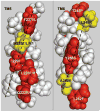Genetic screening of Alzheimer's disease genes in Iberian and African samples yields novel mutations in presenilins and APP
- PMID: 18667258
- PMCID: PMC2850052
- DOI: 10.1016/j.neurobiolaging.2008.06.012
Genetic screening of Alzheimer's disease genes in Iberian and African samples yields novel mutations in presenilins and APP
Abstract
Mutations in three genes (PSEN1, PSEN2, and APP) have been identified in patients with early-onset (<65 years) Alzheimer's disease (AD). We performed a screening for mutations in the coding regions of presenilins, as well as exons 16 and 17 of the APP gene in a total of 231 patients from the Iberian peninsular with a clinical diagnosis of early-onset AD (mean age at onset of 52.9 years; range 31-64). We found three novel mutations in PSEN1, one novel mutation in PSEN2, and a novel mutation in the APP gene. Four previously described mutations in PSEN1 were also found. The same analysis was carried in 121 elderly healthy controls from the Iberian peninsular, and a set of 130 individuals from seven African populations belonging to the Centre d'Etude du Polymorphisme Humain-Human Genome Diversity Panel (CEPH-HGDP), in order to determine the extent of normal variability in these genes. Interestingly, in the latter series, we found five new non-synonymous changes in all three genes and a presenilin 2 variant (R62H) that has been previously related to AD. In some of these mutations, the pathologic consequence is uncertain and needs further investigation. To address this question we propose and use a systematic algorithm to classify the putative pathology of AD mutations.
(c) 2008 Elsevier Inc. All rights reserved.
Conflict of interest statement
The authors have nothing to disclose.
Figures
References
-
- Aldudo J, Bullido MJ, Valdivieso F. DGGE method for the mutational analysis of the coding and proximal promoter regions of the Alzheimer’s disease presenilin-1 gene: two novel mutations. Hum Mutat. 1999;14(5):433–9. - PubMed
-
- American Psychiatric Association. Diagnostic and Statistical Manual of Mental Disorders. 4. Washington DC, USA: 1994.
-
- Boeve BF, Baker M, Dickson DW, Parisi JE, Giannini C, Josephs KA, Hutton M, Pickering-Brown SM, Rademakers R, Tang-Wai D, Jack CR, Jr, Kantarci K, Shiung MM, Golde T, Smith GE, Geda YE, Knopman DS, Petersen RC. Frontotemporal dementia and parkinsonism associated with the IVS1+1G->A mutation in progranulin: a clinicopathologic study. Brain. 2006;129(Pt 11):3103–14. - PubMed
-
- Braak H, Braak E. Neuropathological stageing of Alzheimer-related changes. Acta Neuropathol. 1991;82(4):239–59. - PubMed
-
- Campion D, Dumanchin C, Hannequin D, Dubois B, Belliard S, Puel M, Thomas-Anterion C, Michon A, Martin C, Charbonnier F, Raux G, Camuzat A, Penet C, Mesnage V, Martinez M, Clerget-Darpoux F, Brice A, Frebourg T. Early-onset autosomal dominant Alzheimer disease: prevalence, genetic heterogeneity, and mutation spectrum. Am J Hum Genet. 1999;65(3):664–70. - PMC - PubMed
Publication types
MeSH terms
Substances
Grants and funding
LinkOut - more resources
Full Text Sources
Other Literature Sources
Medical



